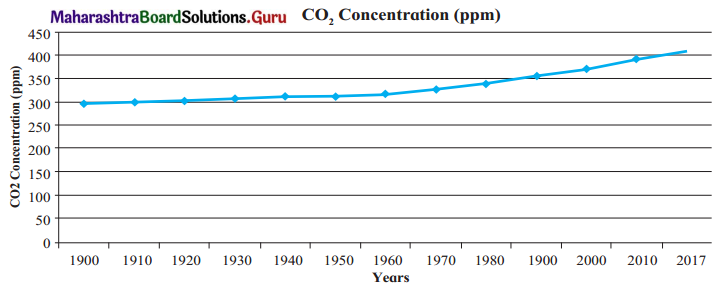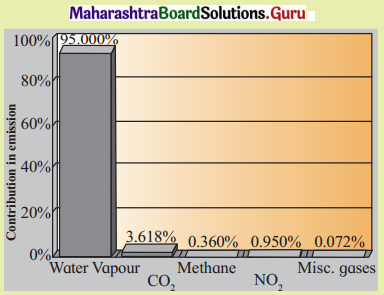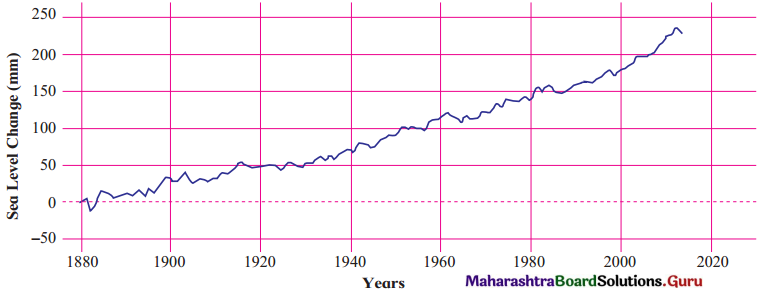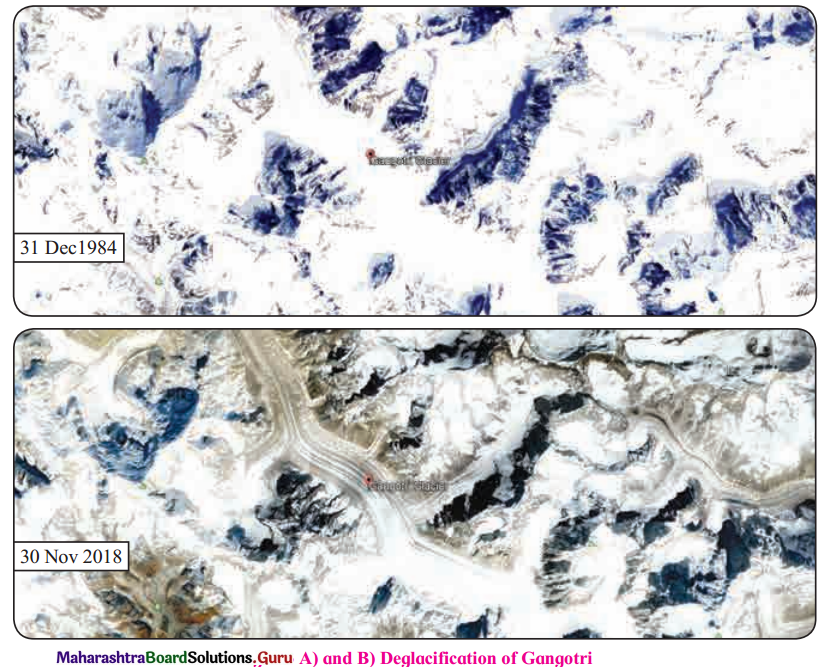Std 11 Geography Chapter 5 Question Answer Global Climate Change Maharashtra Board
Balbharti Maharashtra State Board Class 11 Geography Solutions Chapter 5 Global Climate Change Textbook Exercise Questions and Answers.
Class 11 Geography Chapter 5 Global Climate Change Question Answer Maharashtra Board
Geography Class 11 Chapter 5 Question Answer Maharashtra Board
1. Complete the chain.
Question 1.
| A | B | C |
| (1) Melting of snow | (1) Increase in sea level | (1) Flooding |
| (2) Effects of insolation | (2) Erratic rains | (2) Increase in frequency of cyclones |
| (3) Greenhouse gases | (3) Methane | (3) Agriculture |
| (4) Climate change | (4) Average temperature of the earth | (4) Existence of life on Earth |
Answer:
| A | B | C |
| (1) Melting of snow | (1) Methane | (1) Flooding |
| (2) Effects of insolation | (2) Average temperature of the earth | (2) Agriculture |
| (3) Greenhouse gases | (3) Erratic rains | (3) Existence of life on Earth |
| (4) Climate change | (4) Increase in sea level | (4) Increase in frequency on cyclones |
![]()
2. Identify the incorrect factor.
Question 1.
The causes of global warming-
(a) Emission of greenhouse gases
(b) Deforestation
(c) Apparent movement of the sun
(d) Industrialization
Answer:
(c) Apparent movement of the sun
Question 2.
The indicators of climate change-
(a) Retreat of glaciers
(b) Increase in the frequency of floods
(c) Increase in frequency of cyclones
(d) Increase in the minimum and maximum temperature
Answer:
(d) Increase in the minimum and maximum temperature
Question 3.
The tools for studying climate change
(a) Ice cores
(b) Coral reef
(c) Tree rings
(d) Ancient forts
Answer:
(d) Ancient forts
Question 4.
Measures to combat climate change –
(a) Banning the use of pesticides and insecticides
(b) Promoting afforestation and banning deforestation
(c) Banning public transport
(d) Banning fossil fuels
Answer:
(c) Banning public transport
3. Give geographical reasons.
Question 1.
It is important to study climate change.
Answer:
It is important to study climate change because –
- The earth’s climate is changing faster primarily as a result of human activities.
- Number of flash floods are increasing, especially in urban areas.
- Due to warming of oceans the rate of evaporation is high, which is the root cause of both flooding and droughts.
- Due to increase in temperature, there is melting of snow on mountains and sea level is rising.
- Human activities, especially emissions of heat-trapping greenhouse gases from fossil fuel combustion, deforestation and land use changes are the primary drivers of the climate changes observed in the industrial era.
![]()
Question 2.
There is a great possibility that we may not see Maldives on the world map in the future.
Answer:
There is a great possibility that we may not see Maldives on the world map in the future because-
- Sea level continues to rise at a rate of about 3 mm/ per year, leaving no ground surface higher than 3 m.
- Due to global warming the rising of sea level is likely to worsen.
- Higher sea levels may lead to severe cyclones and periodic flooding of coastal areas.
- Since, Maldives is a flat country there is possibility that it may be submerged under sea water if the rise in sea level continues.
Question 3.
The snowline is retreating.
Answer:
The snowline is retreating because –
- A snowline is a boundary between a snow-covered and snow-free surface. Above the snowline there is permanent snow cover.
- When glaciers and icebergs melt at an alarming rate, it is a cause of concern. This is known as retreating glaciers.
- Due to changes in the climate there is less snowfall as compared to the previous years.
- This means that there is lesser ice formation each year than its rate of melting.
- Thus, due to melting of glaciers and icebergs as well as less snowfall the snowline is retreating.
Question 4.
There is an increase in the frequency of droughts and cyclones.
Answer:
There is an increase in the frequency of droughts and cyclones because-
- In addition to triggering more rainfall, global warming could also increase the occurrence of drought.
- The roots of both flooding and drought lie in the physical process known as evaporation.
- As global warming heats the world’s oceans, the water molecules near the sea surface become more energetic and tend to evaporate into the atmosphere more readily. Thus, water vapour is formed.
- Similarly, due to global warming, the number of cyclones in a year and their intensities have also increased in the tropical regions.
4. Write short notes on.
Question 1.
Bleaching of coral reefs
Answer:
- When temperature changes, corals throw out the algae living in their tissues.
- These algae are responsible for their colour.
- An increase of 1°C – 2°C in ocean temperatures for a long time can lead to bleaching, turning corals white.
- If corals are bleached for prolonged periods, they eventually die.
- Coral bleaching leads to death of large amounts of corals.
![]()
Question 2.
Flash floods
Answer:
- A flash flood is a term that describes floods, which is usually observed in the low-lying areas.
- Floods are caused due to extremely heavy rainfall.
- Flash floods generally occur after the collapse of natural ice, debris dam or a man-made dam, etc.
- Flash foods also occur due to very high precipitation in one day (Mumbai in 2005, Kedarnath in 2013) or because of changed weather conditions like cyclones (Chennai, 2015).
- Flash foods are different from the regular floods by having a time scale of fewer than six hours between rainfall and the onset of flooding.
Question 3.
Tools to study Paleoclimatology
Answer:
Paleoclimatology is the study of the weather and climate of the earth’s past. Scientists and meteorologists have been using instruments to measure climate and weather for the past 140 years. However, millions of years ago historical evidence called proxy data, which includes coral reefs, tree rings, ice cores, etc., were used to tell about the climate.
Coral reefs:
- Coral reefs are very sensitive to changes in climate. –
- Corals form skeletons by extracting calcium carbonate from the ocean waters.
- When the water temperature changes, densities of calcium carbonate in the skeletons also change.
- Coral formed in the summer has a different density than coral formed in the winter.
- This creates seasonal growth rings on the corals.
- Scientists can study these rings to determine the temperature of the water and the season in which the coral grew.
Tree rings:
- There are rings on the stem of the tree.
- Variation in these rings is due to variation in the environmental conditions when they were formed.
- Thus, studying this variation leads to improved understanding of past environmental conditions.
Ice cores:
- These are samples of ice taken from the inner sides of the ice sheets.
- Throughout each year, layers of snow fall over the ice sheets in Greenland and Antarctica.
- Each layer of snow is different.
- Summer snow differs from winter snow.
- Each layer gives scientists a lot of information about the climate each year.
Question 4.
Greenhouse gases
Answer:
- Greenhouse gases are the primary gases, such as, water vapour carbon dioxide, nitrous oxide, methane and ozone in the earth’s atmosphere that absorbs and traps energy from the sun.
- Of all greenhouse gases, carbon dioxide absorbs more heat.
- Without greenhouse gases, the average temperature of the earth’s surface would be about -18°C rather than the present average of 14°C.
- Carbon dioxide emissions comes from many human activities such as combustion of fossil fuels, oil and natural gas, with additional contributions coming from deforestation, changes in land use, soil erosion and agriculture (including live stock).
![]()
5. Answer in detail.
Question 1.
Climate change has not always been anthropogenic in nature. Explain.
Answer:
Though the human activities are a major cause behind climate change, there are some natural causes for climate change. They are as follows:
Amount of energy output by the sun:
- Low energy output by the sun can reduce amount of insolation received by the earth.
- This can lead to cooling of the earth.
Milankovitch Oscillation:
- The earth’s rotation around its own axis and revolution around the sun is responsible for the changes in climate.
- Their changes alter the amount of insolation received from the sun, which in turn might affect its climate.
- It can cause the earth to be closer to the sun (warmer) and farther from the sun (colder).
- The ice ages can occur when we are farther from the sun.
Volcanism:
- Volcanic eruptions throw lots of particulates and aerosols into the atmosphere.
- These aerosols remain in the atmosphere for a considerable period of time.
- The winds spread it around the world, thus reducing the sun’s radiation reaching the earth’s surface.
Goldilocks Zone:
- The earth lies in the habitable zone called the Goldilocks Zone.
- Earth experiences cooler climate, when it was located in the outer reaches of this zone.
- As the size of the sun increases the zone moves outward over time.
- Such changes in the zone causes earth to warm or cool.
![]()
Question 2.
What measures will you suggest to combat climate change in your village/city.
Answer:
Following measures can be taken to combat climate change in our village / city.
- Afforestation should be encouraged in and around play areas, hill sides, schools, etc.
- Deforestation should be avoided strictly.
- The use of public transport should be enabled to lessen the vehicular pollution. Thus, emission of harmful gases such as CO2, etc., can be prevented.
- Use of natural manure can be encouraged instead of using fertilizers.
- In villages, Liquefied Petroleum Gas (LPG) should be used instead of using coal or wood as fuel.
11th Geography Digest Chapter 5 Global Climate Change Intext Questions and Answers
Can you tell? (Textbook Page No. 58)
1. The graph in the figure shows the difference between the global average temperature of the twentieth century and global monthly temperatures from 1985 to 2015. Answer the questions given below.

Question 1.
In which year is the difference the least?
Ans.
Difference in the temperature is least in the year 1985.
Question 2.
What is the difference between the mean temperatures of the twentieth century and temperature in 2015?
Answer:
The difference between the mean temperature of twentieth century (1995-2000) and 2015 is 0.8°C.
Question 3.
Why do the temperatures differ in different months?
Answer:
The temperature differs in different months because of the occurrence of different seasons.
![]()
2. Look at the graph and answer the questions. (Textbook Page No. 63)

Question 1.
What does this graph show?
Ans.
The graph shows CO2 concentration (ppm) and its increased level over the period of time from 1900 to 2017.
Question 2.
What does ppm mean?
Answer:
The abbreviation ppm means ‘parts per million’ of carbon concentration in the atmosphere.
Question 3.
Since which year has the increase been phenomenal?
Answer:
After 1980, there has been a phenomenal increase observed.
Question 4.
Can you think of the reasons behind the increase in carbon dioxide?
Answer:
The reasons behind the increase in carbon dioxide is due to combustion of fossil fuels and large- scale deforestation.
Try this. (Textbook Page No. 59)
1. Look at the following graph. Answer the following question.

Question 1.
Which of these gases has the highest contribution?
Answer:
Water vapour, shows the highest contribution.
![]()
Question 2.
Which of these gases came from natural and man-made sources?
Answer:
Water vapour, methane, NO2 and miscellaneous gases are naturally occurring gases while CO2 is man-made.
Question 3.
Which activities are responsible for their emission?
Answer:
Burning of fossil fuels like coal, etc., and deforestation are responsible for emission of CO2.
Question 4.
Out of these, whose emission can be controlled by humans?
Ans.
The emission of CO2 can be controlled by humans.
Question 2.
Make a list of things you need to change in your lifestyle. (Textbook Page No. 67)
Answer:
- Use of public transport.
- Less use of wood but more use of alternatives to wood.
- Regular maintenance of vehicles.
- Avoid wastage of water.
- Use of energy efficient devices.
- Ban on plastic goods.
- Minimum use of paper in home and office.
- Purchase of only required goods.
- Use of Eco-friendly goods.
- Celebration of festivals without harming the environment.
Find out! (Textbook Page No. 62)
Question 1.
Use internet and reference books on climate change and make a list of species vulnerable to climate change.
Answer:
Species vulnerable to climate change are: corals, polar bear and frogs.
![]()
Question 2.
Make a list of movies based on ice age and climate change. (Textbook Page No. 65)
Answer:
- Interstellar
- Beasts of the Southern Wild
- Chasing Coral
- Snowpiercer
- An Inconvenient Truth
- Are you ready to fight? (Vattaram)
Question 3.
With the help of internet, find out the details of the National Action Plan on Climate Change (NAPCC), 2008 and its missions. (Textbook Page No. 66)
Answer:
NAPCC is a government document that includes eight ambitious goals set for the country to achieve.
- National Solar Mission
- National Mission for Enhanced Energy Efficiency
- National Mission on Sustainable Habitat
- National Water Mission
- National Mission for Sustaining the Himalayan Ecosystem
- National Mission for a “Green India”
- National Mission for Sustainable Agriculture
- National Mission on Strategic Knowledge for Climate Change
1. Look at the graph and answer the following questions. (Textbook Page No. 60)

Question 1.
What does the graph show?
Answer:
The graph shows an increase in the global sea level from 1880 till date.
Question 2.
In which year is the change around 225 mm?
Answer:
The change around 225 mm is observed is the year 2018.
Question 3.
What conclusions can you draw by seeing the graph?
Answer:
With the continued global warming the sea levels are likely to rise.
![]()
Question 4.
What correlation can be seen in this graph and the graph of rising temperature?
Answer:
With the rising temperature the sea level is rising. We can conclude this from both the graphs.
Question 2.
Compare both the satellite images in fig 5.3 (A) and (B). (Textbook Page No. 61)

Answer:
Fig. 5.3 (A) shows the snow-covered Gangotri glacier area in Dec. 1984, whereas in Fig. 5.3 (B) the snow-covered region of the Gangotri glacier has retreated by 2018.
Maharashtra State Board Class 11 Geography Textbook Solutions
- Earth Movements Class 11 Geography Textbook Solutions
- Weathering and Mass Wasting Class 11 Geography Textbook Solutions
- Agents of Erosion Class 11 Geography Textbook Solutions
- Climatic Regions Class 11 Geography Textbook Solutions
- Global Climate Change Class 11 Geography Textbook Solutions
- Ocean Resources Class 11 Geography Textbook Solutions
- Indian Ocean – Relief and Strategic Importance Class 11 Geography Textbook Solutions
- Biomes Class 11 Geography Textbook Solutions
- Disaster Management Class 11 Geography Textbook Solutions